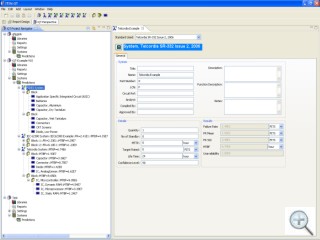Generic Standard Reliability Prediction
The latest release from ITEM Software is an extraordinary collection of new capabilities that provides a customizable, cross-platform, multi-user, open frame-work. Built on proven and recognized analysis engines, ITEM QT (iQT) is a revolutionary approach to reliability, safety, and risk analysis software tools. With iQT, you are no longer limited by the technology choices of software vendors or chained to infrastructure requirements of their products.
The Generic prediction standard editor is provided within the iQT platform. Users can easily customize or create their own prediction standard without any modification in the code. The new standard is automatically recognized in the platform. No coding is needed. User are able to mix the different prediction standards already purchased and customize formulae to suit.
iQT provides a function to allow users to check the implementation of all built-in prediction standards.
The purpose of a reliability prediction model is to estimate the "rate of occurrence of failure" and accelerants of a component's primary failure mechanisms within an acceptable degree of accuracy. With that in mind, the models should be adequately sensitive to operating scenarios and stresses, so that they allow the user the ability to perform "what if" analysis among these variables.
Focused on reliability, safety, and risk assessment, our iQT product is a highly extensible framework that provides common infrastructure for any kind of system modeling.
The capable nature of iQT is achieved by an existing Java platform foundation that is widely supported in your business environment. By following the predefined interface, your team has the ability to create plug-ins that extend the capabilities of iQT . The following are examples of possible iQT extensions:
- New editors or viewers for a given model (file) type
- New quantification model types
- New result types
- New analysis engines
The well-established core services of this platform provide the essential functionality to model and analyze reliability, risk and safety projects. Regardless of the configuration of a particular installation, the core services are available in the framework.
All extensions are highly modular. By allowing capabilities to be added to or removed from the software without affecting other extensions, new functionality, perhaps a new prediction standard, can be added without requiring reconfiguration or redesign of the source code.
iQT is a fully functional open environment, supporting the addition of third-party plug-ins such as:
- Version management plug-ins
- Project management plug-ins
- Third-party computational environment tools (e.g. MATLAB)
- Third-party modeling tools (e.g. data analysis)
- Documentation tools (e.g. PDF viewers)
- Search tools
- Customizable, cross-platform, multi-user, open-framework
- Built on proven and recognized analysis engines
- Update manager allows the user to upgrade to the latest version online
- Refrains from loading and creating models until needed, dramatically reducing memory usage and startup times
- Easily create or modify existing prediction approach with a prediction module editor
- True cross-platform capabilities through Java-based framework and analysis engines
- Library function allows automated update of models
- Easily revert to any previous version of a model
- Restrict access to particular models to one user or group
- Create different branches and variations of the same model for 'what if' investigations
- Merge project work from multiple teams into a single project
- Designed by engineers for engineers
- Fully functional open environment supporting addition of third party plug-ins
- Stores external documentation like MS Word, PDF or CAD drawing files
- Configurable to interface with other programs
- Powerful, proven and configurable quantification engines
- Open standard allows users to make changes to the model outside of iQT
|

> Reliability Prediction Software
> Generic User Defined Standard
> Customizable, Multi-User, Open-Framework
> True Cross-Platform Capabilities
> Modular Design Allows Choice of Analyses
> Supports Third-Party Plug-Ins
> Extensive Reporting and Charting Facilities
> Stores External Documentation
> Configurable Quantification Engines
|